Analyzing Population and Migration in Asia: A Human Geography Essay
VerifiedAdded on 2023/04/10
|12
|1547
|413
Essay
AI Summary
This essay examines population and migration patterns in Asia, focusing on the demographic impacts and related consequences. It considers various migration types, including labor migration and brain drain, and their effects on sex ratios, population growth, and demographic characteristics. The essay also discusses the economic implications of these trends, such as changes in dependency ratios and income distribution. Examples from Pacific island nations and major Asian countries like China and India are used to illustrate these points. The analysis includes a review of population pyramids and migration rates to highlight the shifts and imbalances caused by migration flows within the region.
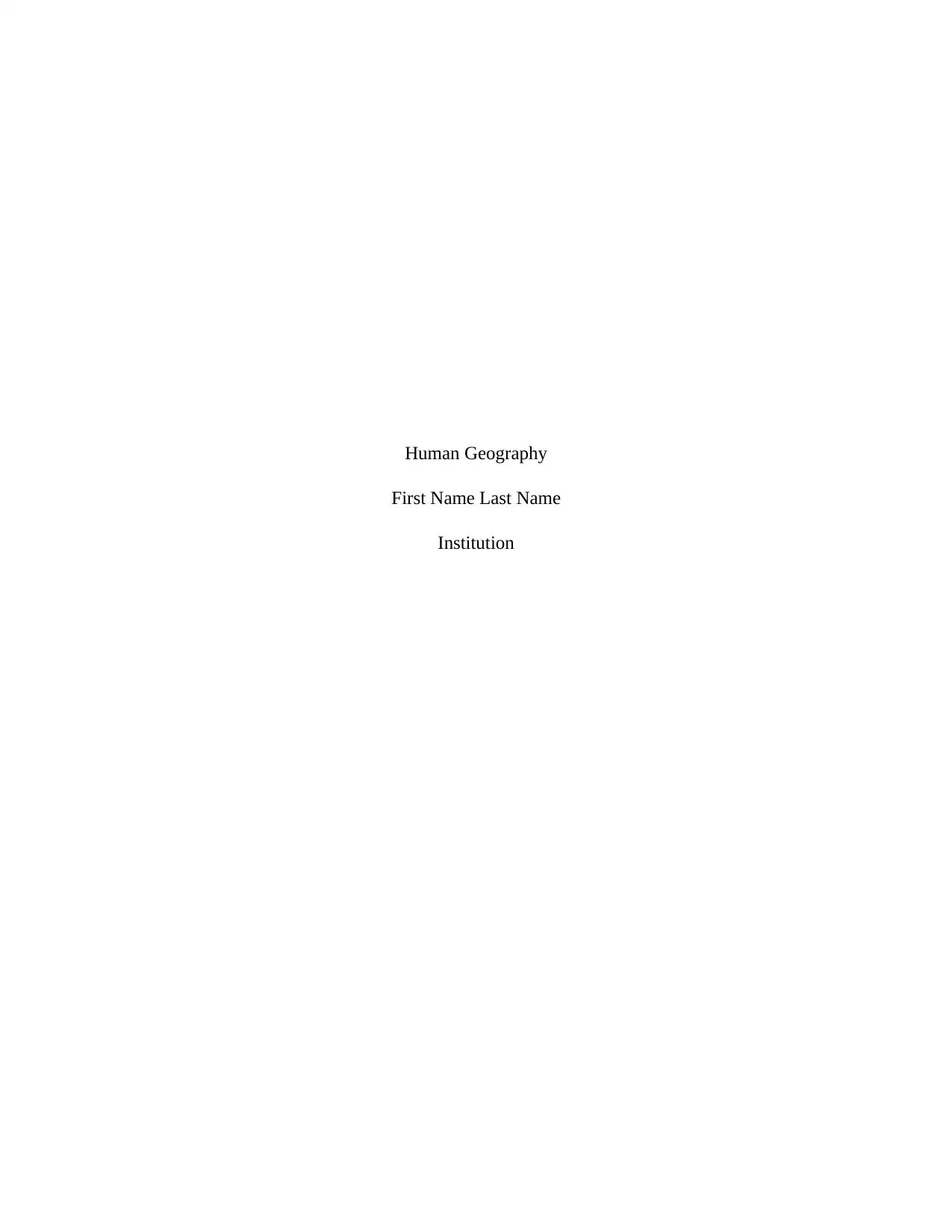
Human Geography
First Name Last Name
Institution
First Name Last Name
Institution
Paraphrase This Document
Need a fresh take? Get an instant paraphrase of this document with our AI Paraphraser
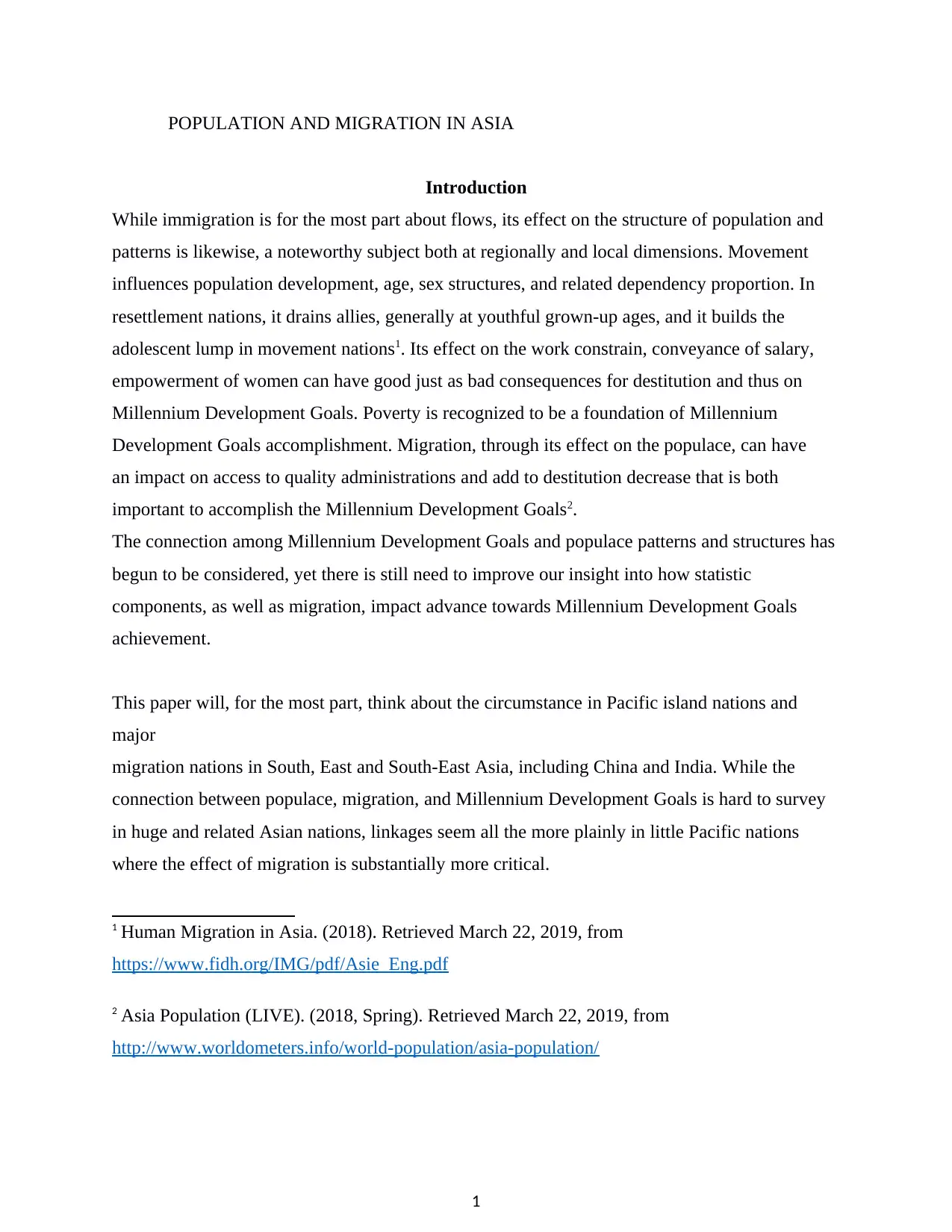
POPULATION AND MIGRATION IN ASIA
Introduction
While immigration is for the most part about flows, its effect on the structure of population and
patterns is likewise, a noteworthy subject both at regionally and local dimensions. Movement
influences population development, age, sex structures, and related dependency proportion. In
resettlement nations, it drains allies, generally at youthful grown-up ages, and it builds the
adolescent lump in movement nations1. Its effect on the work constrain, conveyance of salary,
empowerment of women can have good just as bad consequences for destitution and thus on
Millennium Development Goals. Poverty is recognized to be a foundation of Millennium
Development Goals accomplishment. Migration, through its effect on the populace, can have
an impact on access to quality administrations and add to destitution decrease that is both
important to accomplish the Millennium Development Goals2.
The connection among Millennium Development Goals and populace patterns and structures has
begun to be considered, yet there is still need to improve our insight into how statistic
components, as well as migration, impact advance towards Millennium Development Goals
achievement.
This paper will, for the most part, think about the circumstance in Pacific island nations and
major
migration nations in South, East and South-East Asia, including China and India. While the
connection between populace, migration, and Millennium Development Goals is hard to survey
in huge and related Asian nations, linkages seem all the more plainly in little Pacific nations
where the effect of migration is substantially more critical.
1 Human Migration in Asia. (2018). Retrieved March 22, 2019, from
https://www.fidh.org/IMG/pdf/Asie_Eng.pdf
2 Asia Population (LIVE). (2018, Spring). Retrieved March 22, 2019, from
http://www.worldometers.info/world-population/asia-population/
1
Introduction
While immigration is for the most part about flows, its effect on the structure of population and
patterns is likewise, a noteworthy subject both at regionally and local dimensions. Movement
influences population development, age, sex structures, and related dependency proportion. In
resettlement nations, it drains allies, generally at youthful grown-up ages, and it builds the
adolescent lump in movement nations1. Its effect on the work constrain, conveyance of salary,
empowerment of women can have good just as bad consequences for destitution and thus on
Millennium Development Goals. Poverty is recognized to be a foundation of Millennium
Development Goals accomplishment. Migration, through its effect on the populace, can have
an impact on access to quality administrations and add to destitution decrease that is both
important to accomplish the Millennium Development Goals2.
The connection among Millennium Development Goals and populace patterns and structures has
begun to be considered, yet there is still need to improve our insight into how statistic
components, as well as migration, impact advance towards Millennium Development Goals
achievement.
This paper will, for the most part, think about the circumstance in Pacific island nations and
major
migration nations in South, East and South-East Asia, including China and India. While the
connection between populace, migration, and Millennium Development Goals is hard to survey
in huge and related Asian nations, linkages seem all the more plainly in little Pacific nations
where the effect of migration is substantially more critical.
1 Human Migration in Asia. (2018). Retrieved March 22, 2019, from
https://www.fidh.org/IMG/pdf/Asie_Eng.pdf
2 Asia Population (LIVE). (2018, Spring). Retrieved March 22, 2019, from
http://www.worldometers.info/world-population/asia-population/
1
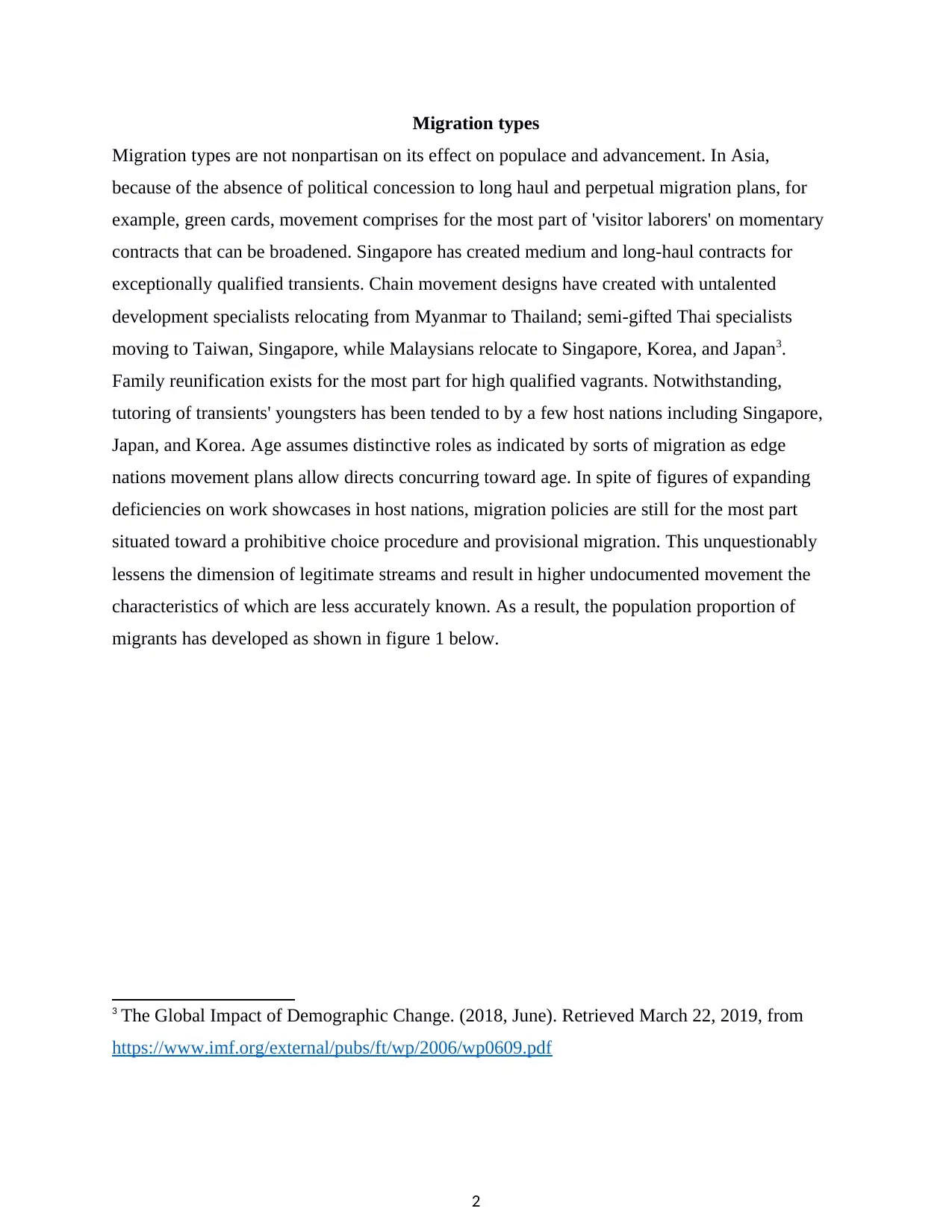
Migration types
Migration types are not nonpartisan on its effect on populace and advancement. In Asia,
because of the absence of political concession to long haul and perpetual migration plans, for
example, green cards, movement comprises for the most part of 'visitor laborers' on momentary
contracts that can be broadened. Singapore has created medium and long-haul contracts for
exceptionally qualified transients. Chain movement designs have created with untalented
development specialists relocating from Myanmar to Thailand; semi-gifted Thai specialists
moving to Taiwan, Singapore, while Malaysians relocate to Singapore, Korea, and Japan3.
Family reunification exists for the most part for high qualified vagrants. Notwithstanding,
tutoring of transients' youngsters has been tended to by a few host nations including Singapore,
Japan, and Korea. Age assumes distinctive roles as indicated by sorts of migration as edge
nations movement plans allow directs concurring toward age. In spite of figures of expanding
deficiencies on work showcases in host nations, migration policies are still for the most part
situated toward a prohibitive choice procedure and provisional migration. This unquestionably
lessens the dimension of legitimate streams and result in higher undocumented movement the
characteristics of which are less accurately known. As a result, the population proportion of
migrants has developed as shown in figure 1 below.
3 The Global Impact of Demographic Change. (2018, June). Retrieved March 22, 2019, from
https://www.imf.org/external/pubs/ft/wp/2006/wp0609.pdf
2
Migration types are not nonpartisan on its effect on populace and advancement. In Asia,
because of the absence of political concession to long haul and perpetual migration plans, for
example, green cards, movement comprises for the most part of 'visitor laborers' on momentary
contracts that can be broadened. Singapore has created medium and long-haul contracts for
exceptionally qualified transients. Chain movement designs have created with untalented
development specialists relocating from Myanmar to Thailand; semi-gifted Thai specialists
moving to Taiwan, Singapore, while Malaysians relocate to Singapore, Korea, and Japan3.
Family reunification exists for the most part for high qualified vagrants. Notwithstanding,
tutoring of transients' youngsters has been tended to by a few host nations including Singapore,
Japan, and Korea. Age assumes distinctive roles as indicated by sorts of migration as edge
nations movement plans allow directs concurring toward age. In spite of figures of expanding
deficiencies on work showcases in host nations, migration policies are still for the most part
situated toward a prohibitive choice procedure and provisional migration. This unquestionably
lessens the dimension of legitimate streams and result in higher undocumented movement the
characteristics of which are less accurately known. As a result, the population proportion of
migrants has developed as shown in figure 1 below.
3 The Global Impact of Demographic Change. (2018, June). Retrieved March 22, 2019, from
https://www.imf.org/external/pubs/ft/wp/2006/wp0609.pdf
2
⊘ This is a preview!⊘
Do you want full access?
Subscribe today to unlock all pages.

Trusted by 1+ million students worldwide
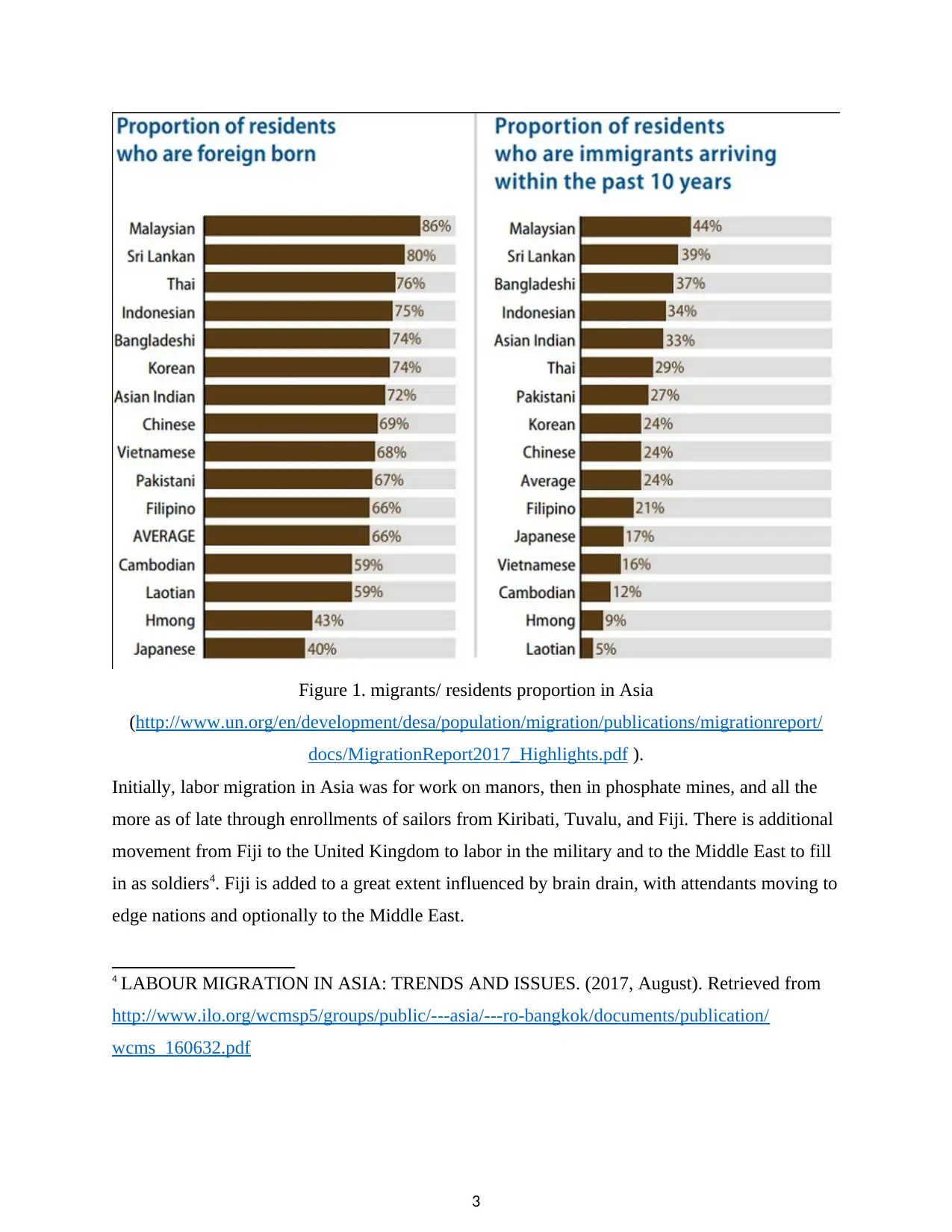
Figure 1. migrants/ residents proportion in Asia
(http://www.un.org/en/development/desa/population/migration/publications/migrationreport/
docs/MigrationReport2017_Highlights.pdf ).
Initially, labor migration in Asia was for work on manors, then in phosphate mines, and all the
more as of late through enrollments of sailors from Kiribati, Tuvalu, and Fiji. There is additional
movement from Fiji to the United Kingdom to labor in the military and to the Middle East to fill
in as soldiers4. Fiji is added to a great extent influenced by brain drain, with attendants moving to
edge nations and optionally to the Middle East.
4 LABOUR MIGRATION IN ASIA: TRENDS AND ISSUES. (2017, August). Retrieved from
http://www.ilo.org/wcmsp5/groups/public/---asia/---ro-bangkok/documents/publication/
wcms_160632.pdf
3
(http://www.un.org/en/development/desa/population/migration/publications/migrationreport/
docs/MigrationReport2017_Highlights.pdf ).
Initially, labor migration in Asia was for work on manors, then in phosphate mines, and all the
more as of late through enrollments of sailors from Kiribati, Tuvalu, and Fiji. There is additional
movement from Fiji to the United Kingdom to labor in the military and to the Middle East to fill
in as soldiers4. Fiji is added to a great extent influenced by brain drain, with attendants moving to
edge nations and optionally to the Middle East.
4 LABOUR MIGRATION IN ASIA: TRENDS AND ISSUES. (2017, August). Retrieved from
http://www.ilo.org/wcmsp5/groups/public/---asia/---ro-bangkok/documents/publication/
wcms_160632.pdf
3
Paraphrase This Document
Need a fresh take? Get an instant paraphrase of this document with our AI Paraphraser
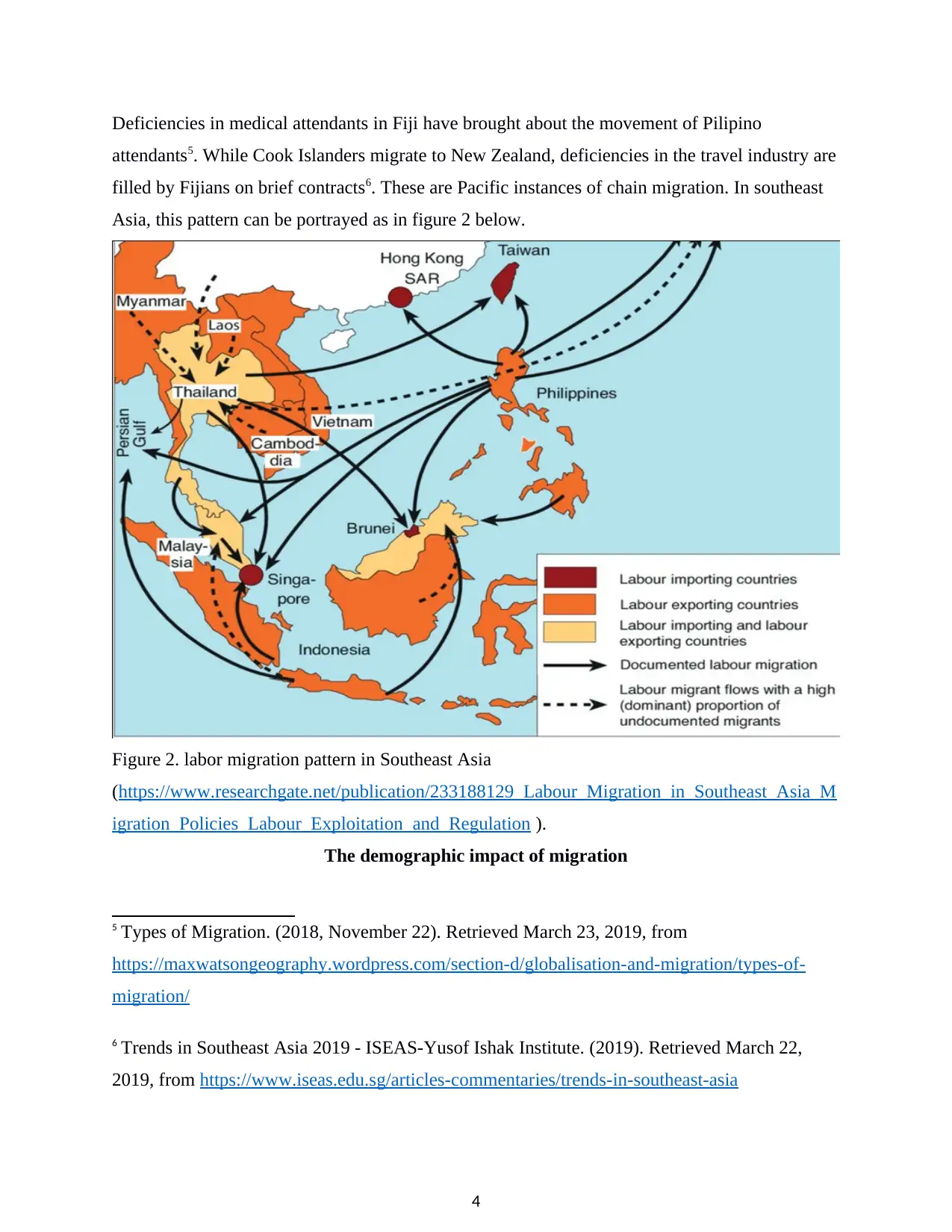
Deficiencies in medical attendants in Fiji have brought about the movement of Pilipino
attendants5. While Cook Islanders migrate to New Zealand, deficiencies in the travel industry are
filled by Fijians on brief contracts6. These are Pacific instances of chain migration. In southeast
Asia, this pattern can be portrayed as in figure 2 below.
Figure 2. labor migration pattern in Southeast Asia
(https://www.researchgate.net/publication/233188129_Labour_Migration_in_Southeast_Asia_M
igration_Policies_Labour_Exploitation_and_Regulation ).
The demographic impact of migration
5 Types of Migration. (2018, November 22). Retrieved March 23, 2019, from
https://maxwatsongeography.wordpress.com/section-d/globalisation-and-migration/types-of-
migration/
6 Trends in Southeast Asia 2019 - ISEAS-Yusof Ishak Institute. (2019). Retrieved March 22,
2019, from https://www.iseas.edu.sg/articles-commentaries/trends-in-southeast-asia
4
attendants5. While Cook Islanders migrate to New Zealand, deficiencies in the travel industry are
filled by Fijians on brief contracts6. These are Pacific instances of chain migration. In southeast
Asia, this pattern can be portrayed as in figure 2 below.
Figure 2. labor migration pattern in Southeast Asia
(https://www.researchgate.net/publication/233188129_Labour_Migration_in_Southeast_Asia_M
igration_Policies_Labour_Exploitation_and_Regulation ).
The demographic impact of migration
5 Types of Migration. (2018, November 22). Retrieved March 23, 2019, from
https://maxwatsongeography.wordpress.com/section-d/globalisation-and-migration/types-of-
migration/
6 Trends in Southeast Asia 2019 - ISEAS-Yusof Ishak Institute. (2019). Retrieved March 22,
2019, from https://www.iseas.edu.sg/articles-commentaries/trends-in-southeast-asia
4
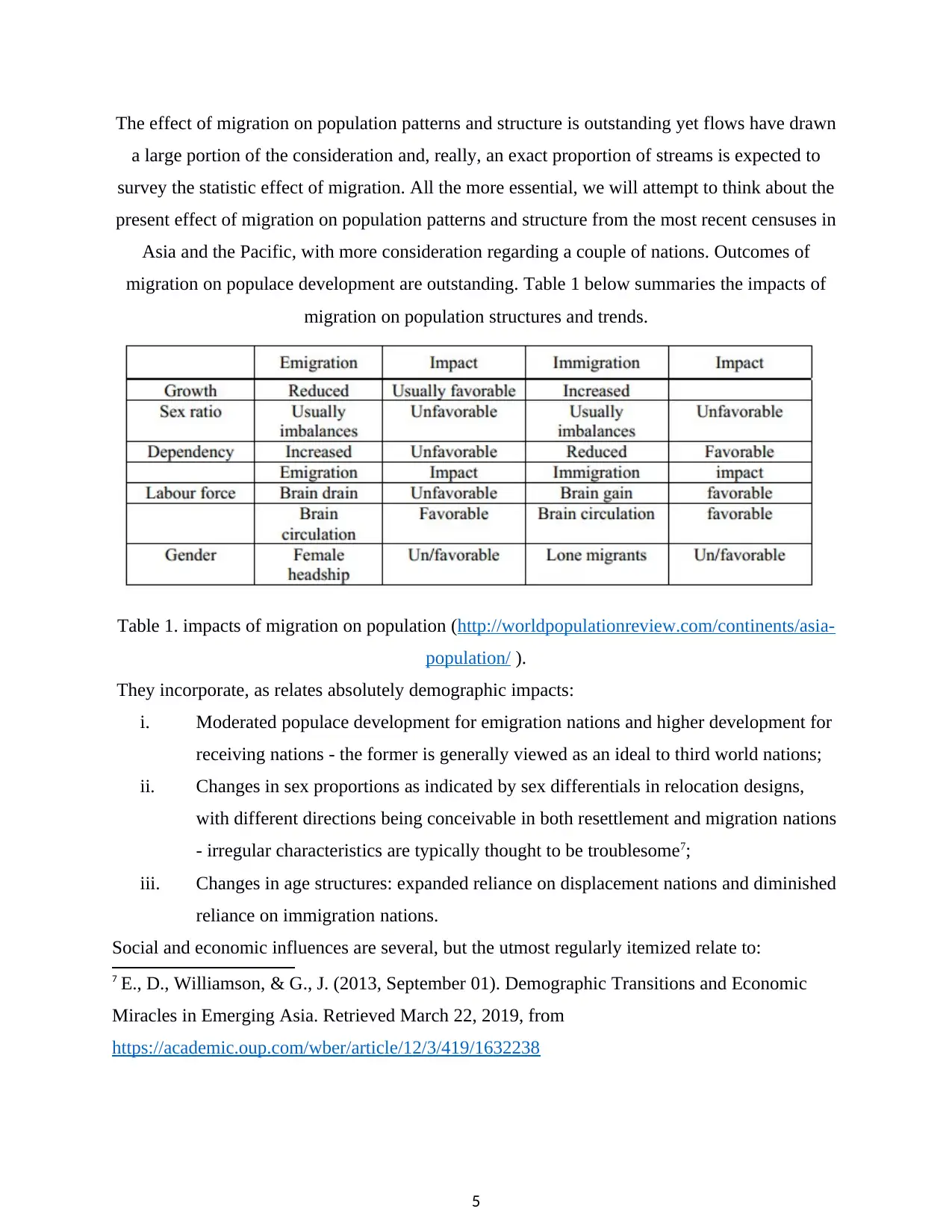
The effect of migration on population patterns and structure is outstanding yet flows have drawn
a large portion of the consideration and, really, an exact proportion of streams is expected to
survey the statistic effect of migration. All the more essential, we will attempt to think about the
present effect of migration on population patterns and structure from the most recent censuses in
Asia and the Pacific, with more consideration regarding a couple of nations. Outcomes of
migration on populace development are outstanding. Table 1 below summaries the impacts of
migration on population structures and trends.
Table 1. impacts of migration on population (http://worldpopulationreview.com/continents/asia-
population/ ).
They incorporate, as relates absolutely demographic impacts:
i. Moderated populace development for emigration nations and higher development for
receiving nations - the former is generally viewed as an ideal to third world nations;
ii. Changes in sex proportions as indicated by sex differentials in relocation designs,
with different directions being conceivable in both resettlement and migration nations
- irregular characteristics are typically thought to be troublesome7;
iii. Changes in age structures: expanded reliance on displacement nations and diminished
reliance on immigration nations.
Social and economic influences are several, but the utmost regularly itemized relate to:
7 E., D., Williamson, & G., J. (2013, September 01). Demographic Transitions and Economic
Miracles in Emerging Asia. Retrieved March 22, 2019, from
https://academic.oup.com/wber/article/12/3/419/1632238
5
a large portion of the consideration and, really, an exact proportion of streams is expected to
survey the statistic effect of migration. All the more essential, we will attempt to think about the
present effect of migration on population patterns and structure from the most recent censuses in
Asia and the Pacific, with more consideration regarding a couple of nations. Outcomes of
migration on populace development are outstanding. Table 1 below summaries the impacts of
migration on population structures and trends.
Table 1. impacts of migration on population (http://worldpopulationreview.com/continents/asia-
population/ ).
They incorporate, as relates absolutely demographic impacts:
i. Moderated populace development for emigration nations and higher development for
receiving nations - the former is generally viewed as an ideal to third world nations;
ii. Changes in sex proportions as indicated by sex differentials in relocation designs,
with different directions being conceivable in both resettlement and migration nations
- irregular characteristics are typically thought to be troublesome7;
iii. Changes in age structures: expanded reliance on displacement nations and diminished
reliance on immigration nations.
Social and economic influences are several, but the utmost regularly itemized relate to:
7 E., D., Williamson, & G., J. (2013, September 01). Demographic Transitions and Economic
Miracles in Emerging Asia. Retrieved March 22, 2019, from
https://academic.oup.com/wber/article/12/3/419/1632238
5
⊘ This is a preview!⊘
Do you want full access?
Subscribe today to unlock all pages.

Trusted by 1+ million students worldwide
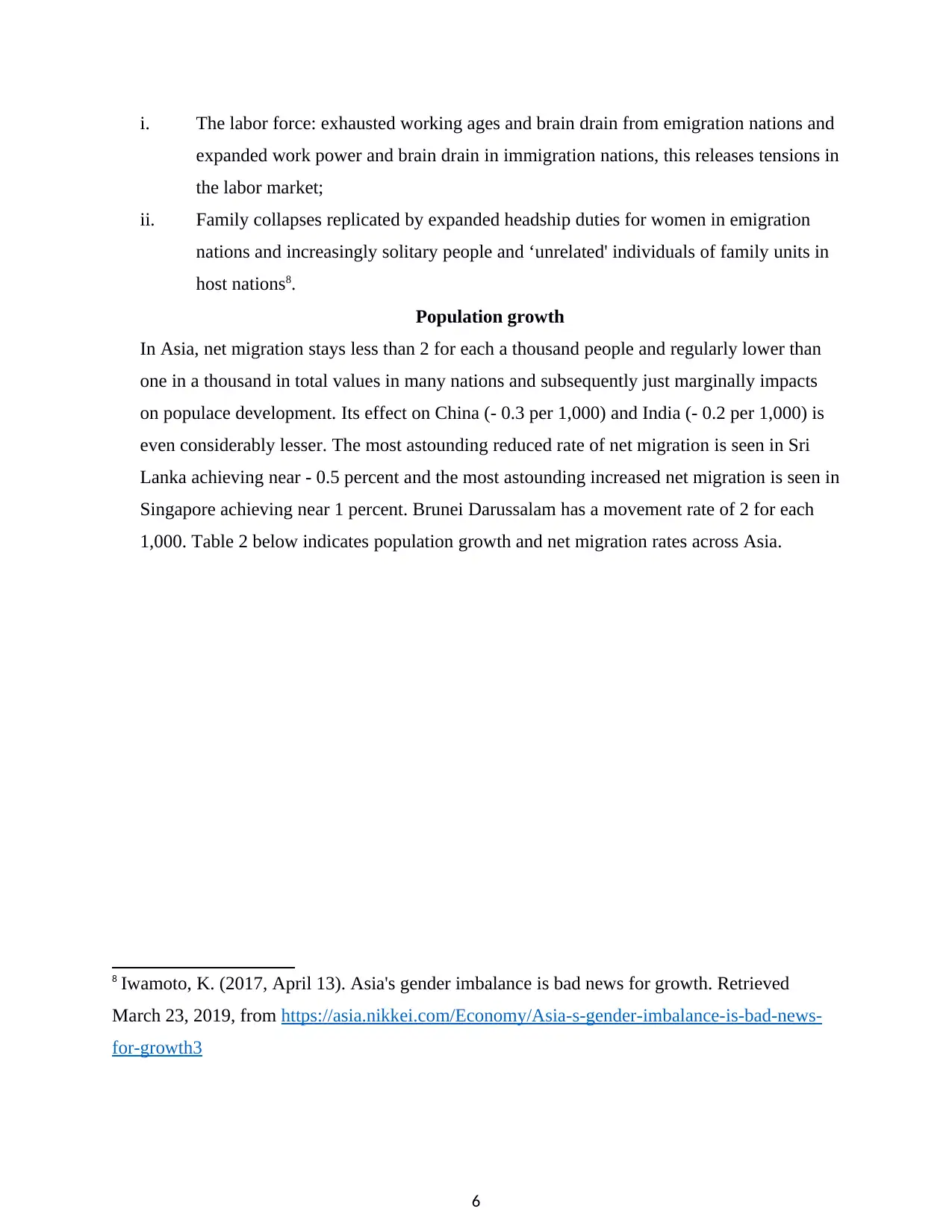
i. The labor force: exhausted working ages and brain drain from emigration nations and
expanded work power and brain drain in immigration nations, this releases tensions in
the labor market;
ii. Family collapses replicated by expanded headship duties for women in emigration
nations and increasingly solitary people and ‘unrelated' individuals of family units in
host nations8.
Population growth
In Asia, net migration stays less than 2 for each a thousand people and regularly lower than
one in a thousand in total values in many nations and subsequently just marginally impacts
on populace development. Its effect on China (- 0.3 per 1,000) and India (- 0.2 per 1,000) is
even considerably lesser. The most astounding reduced rate of net migration is seen in Sri
Lanka achieving near - 0.5 percent and the most astounding increased net migration is seen in
Singapore achieving near 1 percent. Brunei Darussalam has a movement rate of 2 for each
1,000. Table 2 below indicates population growth and net migration rates across Asia.
8 Iwamoto, K. (2017, April 13). Asia's gender imbalance is bad news for growth. Retrieved
March 23, 2019, from https://asia.nikkei.com/Economy/Asia-s-gender-imbalance-is-bad-news-
for-growth3
6
expanded work power and brain drain in immigration nations, this releases tensions in
the labor market;
ii. Family collapses replicated by expanded headship duties for women in emigration
nations and increasingly solitary people and ‘unrelated' individuals of family units in
host nations8.
Population growth
In Asia, net migration stays less than 2 for each a thousand people and regularly lower than
one in a thousand in total values in many nations and subsequently just marginally impacts
on populace development. Its effect on China (- 0.3 per 1,000) and India (- 0.2 per 1,000) is
even considerably lesser. The most astounding reduced rate of net migration is seen in Sri
Lanka achieving near - 0.5 percent and the most astounding increased net migration is seen in
Singapore achieving near 1 percent. Brunei Darussalam has a movement rate of 2 for each
1,000. Table 2 below indicates population growth and net migration rates across Asia.
8 Iwamoto, K. (2017, April 13). Asia's gender imbalance is bad news for growth. Retrieved
March 23, 2019, from https://asia.nikkei.com/Economy/Asia-s-gender-imbalance-is-bad-news-
for-growth3
6
Paraphrase This Document
Need a fresh take? Get an instant paraphrase of this document with our AI Paraphraser
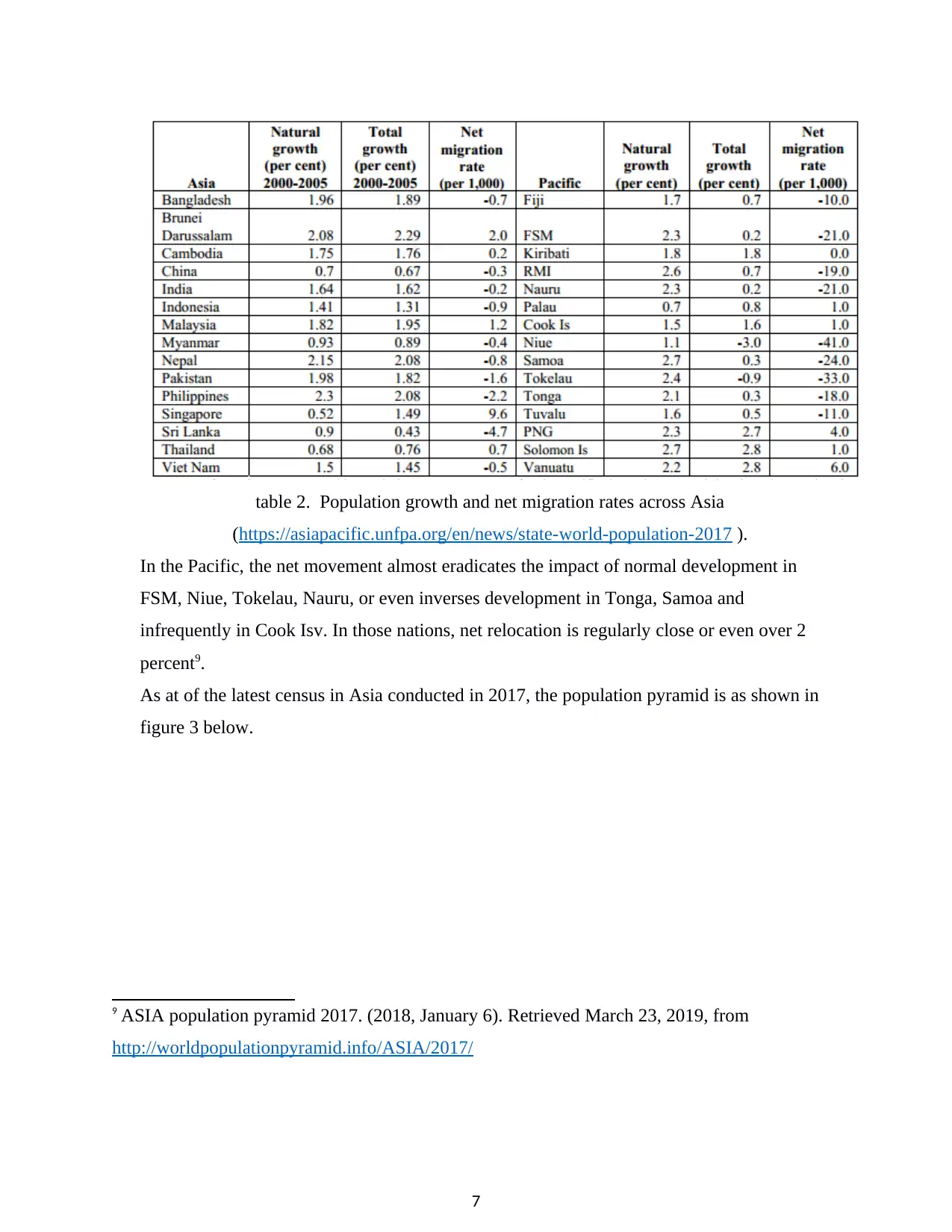
table 2. Population growth and net migration rates across Asia
(https://asiapacific.unfpa.org/en/news/state-world-population-2017 ).
In the Pacific, the net movement almost eradicates the impact of normal development in
FSM, Niue, Tokelau, Nauru, or even inverses development in Tonga, Samoa and
infrequently in Cook Isv. In those nations, net relocation is regularly close or even over 2
percent9.
As at of the latest census in Asia conducted in 2017, the population pyramid is as shown in
figure 3 below.
9 ASIA population pyramid 2017. (2018, January 6). Retrieved March 23, 2019, from
http://worldpopulationpyramid.info/ASIA/2017/
7
(https://asiapacific.unfpa.org/en/news/state-world-population-2017 ).
In the Pacific, the net movement almost eradicates the impact of normal development in
FSM, Niue, Tokelau, Nauru, or even inverses development in Tonga, Samoa and
infrequently in Cook Isv. In those nations, net relocation is regularly close or even over 2
percent9.
As at of the latest census in Asia conducted in 2017, the population pyramid is as shown in
figure 3 below.
9 ASIA population pyramid 2017. (2018, January 6). Retrieved March 23, 2019, from
http://worldpopulationpyramid.info/ASIA/2017/
7
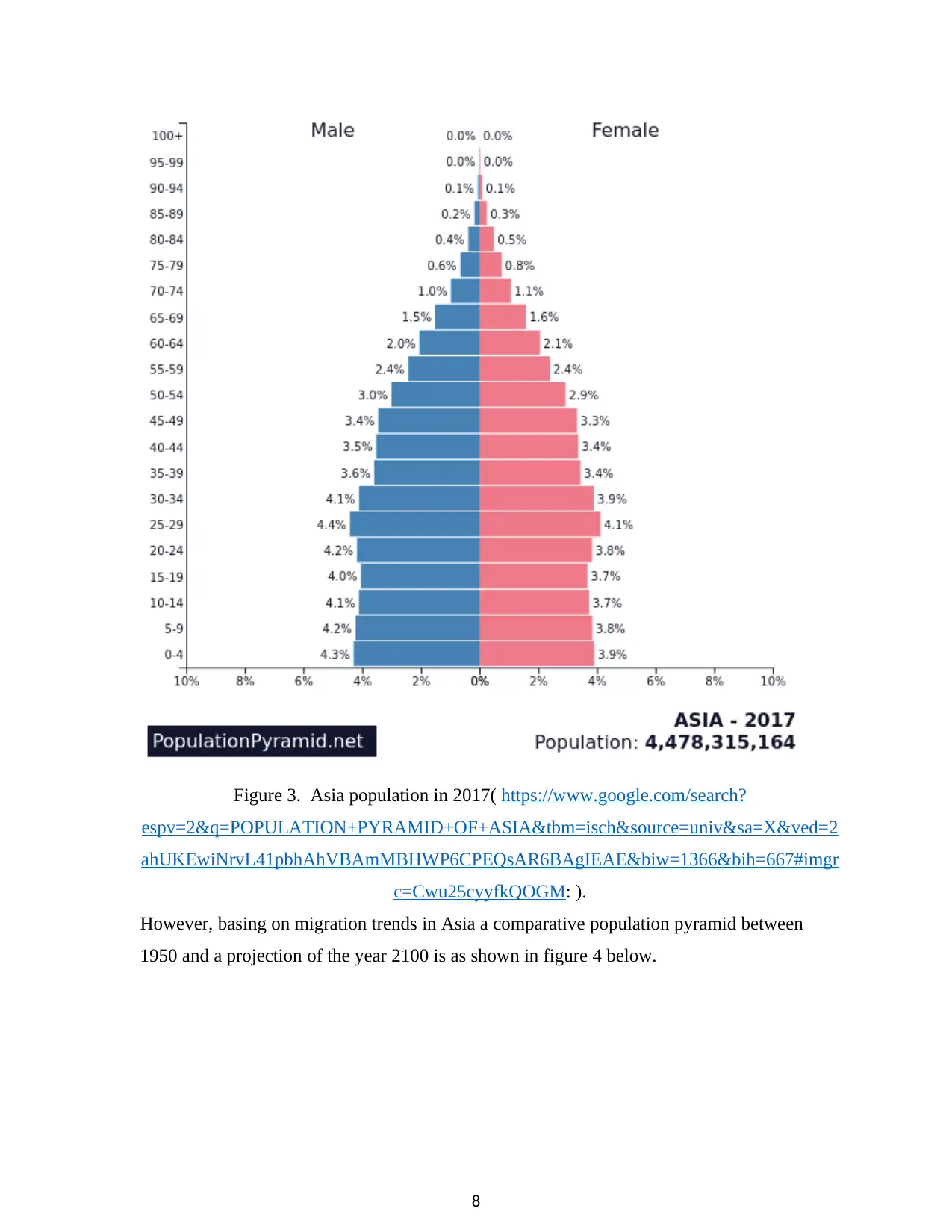
Figure 3. Asia population in 2017( https://www.google.com/search?
espv=2&q=POPULATION+PYRAMID+OF+ASIA&tbm=isch&source=univ&sa=X&ved=2
ahUKEwiNrvL41pbhAhVBAmMBHWP6CPEQsAR6BAgIEAE&biw=1366&bih=667#imgr
c=Cwu25cyyfkQOGM: ).
However, basing on migration trends in Asia a comparative population pyramid between
1950 and a projection of the year 2100 is as shown in figure 4 below.
8
espv=2&q=POPULATION+PYRAMID+OF+ASIA&tbm=isch&source=univ&sa=X&ved=2
ahUKEwiNrvL41pbhAhVBAmMBHWP6CPEQsAR6BAgIEAE&biw=1366&bih=667#imgr
c=Cwu25cyyfkQOGM: ).
However, basing on migration trends in Asia a comparative population pyramid between
1950 and a projection of the year 2100 is as shown in figure 4 below.
8
⊘ This is a preview!⊘
Do you want full access?
Subscribe today to unlock all pages.

Trusted by 1+ million students worldwide
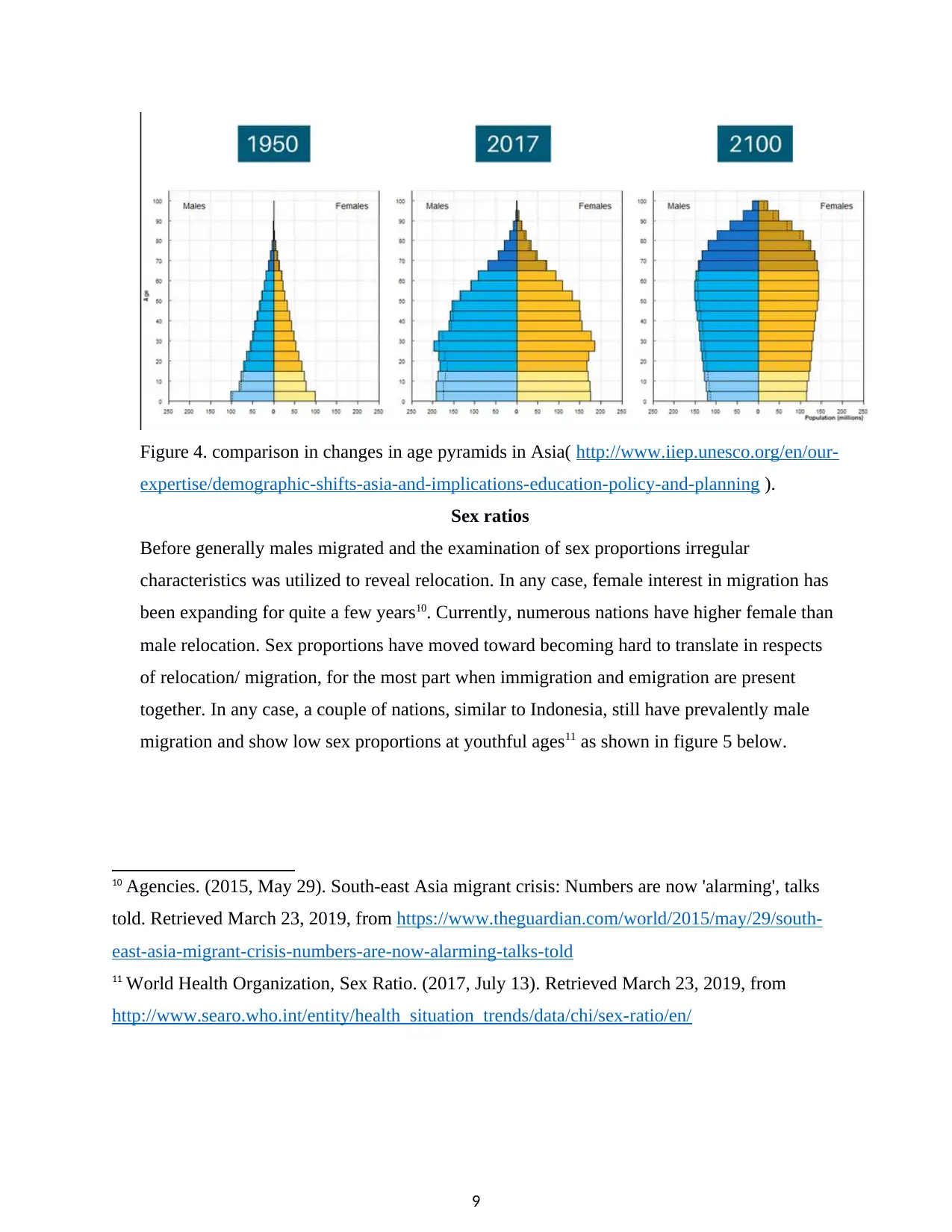
Figure 4. comparison in changes in age pyramids in Asia( http://www.iiep.unesco.org/en/our-
expertise/demographic-shifts-asia-and-implications-education-policy-and-planning ).
Sex ratios
Before generally males migrated and the examination of sex proportions irregular
characteristics was utilized to reveal relocation. In any case, female interest in migration has
been expanding for quite a few years10. Currently, numerous nations have higher female than
male relocation. Sex proportions have moved toward becoming hard to translate in respects
of relocation/ migration, for the most part when immigration and emigration are present
together. In any case, a couple of nations, similar to Indonesia, still have prevalently male
migration and show low sex proportions at youthful ages11 as shown in figure 5 below.
10 Agencies. (2015, May 29). South-east Asia migrant crisis: Numbers are now 'alarming', talks
told. Retrieved March 23, 2019, from https://www.theguardian.com/world/2015/may/29/south-
east-asia-migrant-crisis-numbers-are-now-alarming-talks-told
11 World Health Organization, Sex Ratio. (2017, July 13). Retrieved March 23, 2019, from
http://www.searo.who.int/entity/health_situation_trends/data/chi/sex-ratio/en/
9
expertise/demographic-shifts-asia-and-implications-education-policy-and-planning ).
Sex ratios
Before generally males migrated and the examination of sex proportions irregular
characteristics was utilized to reveal relocation. In any case, female interest in migration has
been expanding for quite a few years10. Currently, numerous nations have higher female than
male relocation. Sex proportions have moved toward becoming hard to translate in respects
of relocation/ migration, for the most part when immigration and emigration are present
together. In any case, a couple of nations, similar to Indonesia, still have prevalently male
migration and show low sex proportions at youthful ages11 as shown in figure 5 below.
10 Agencies. (2015, May 29). South-east Asia migrant crisis: Numbers are now 'alarming', talks
told. Retrieved March 23, 2019, from https://www.theguardian.com/world/2015/may/29/south-
east-asia-migrant-crisis-numbers-are-now-alarming-talks-told
11 World Health Organization, Sex Ratio. (2017, July 13). Retrieved March 23, 2019, from
http://www.searo.who.int/entity/health_situation_trends/data/chi/sex-ratio/en/
9
Paraphrase This Document
Need a fresh take? Get an instant paraphrase of this document with our AI Paraphraser
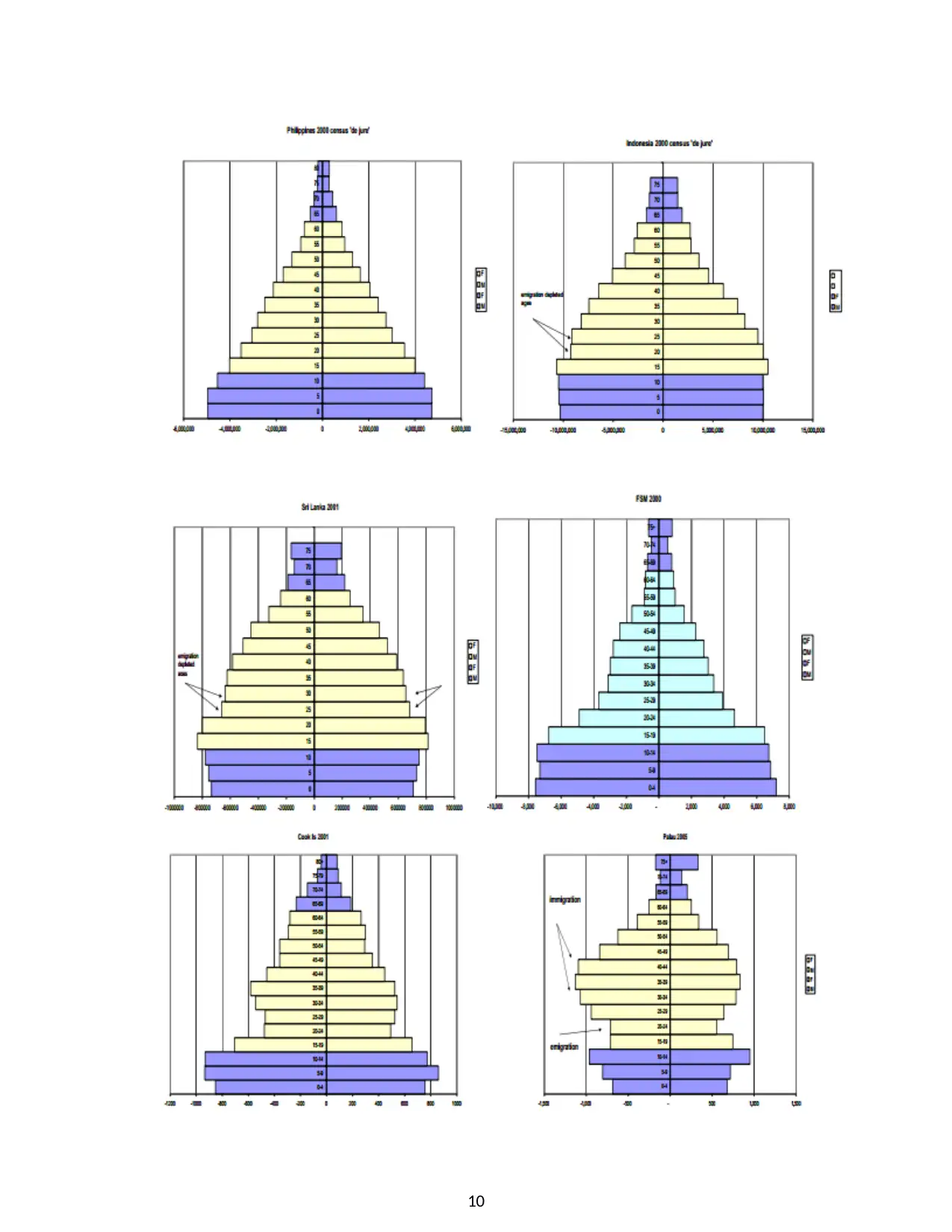
10
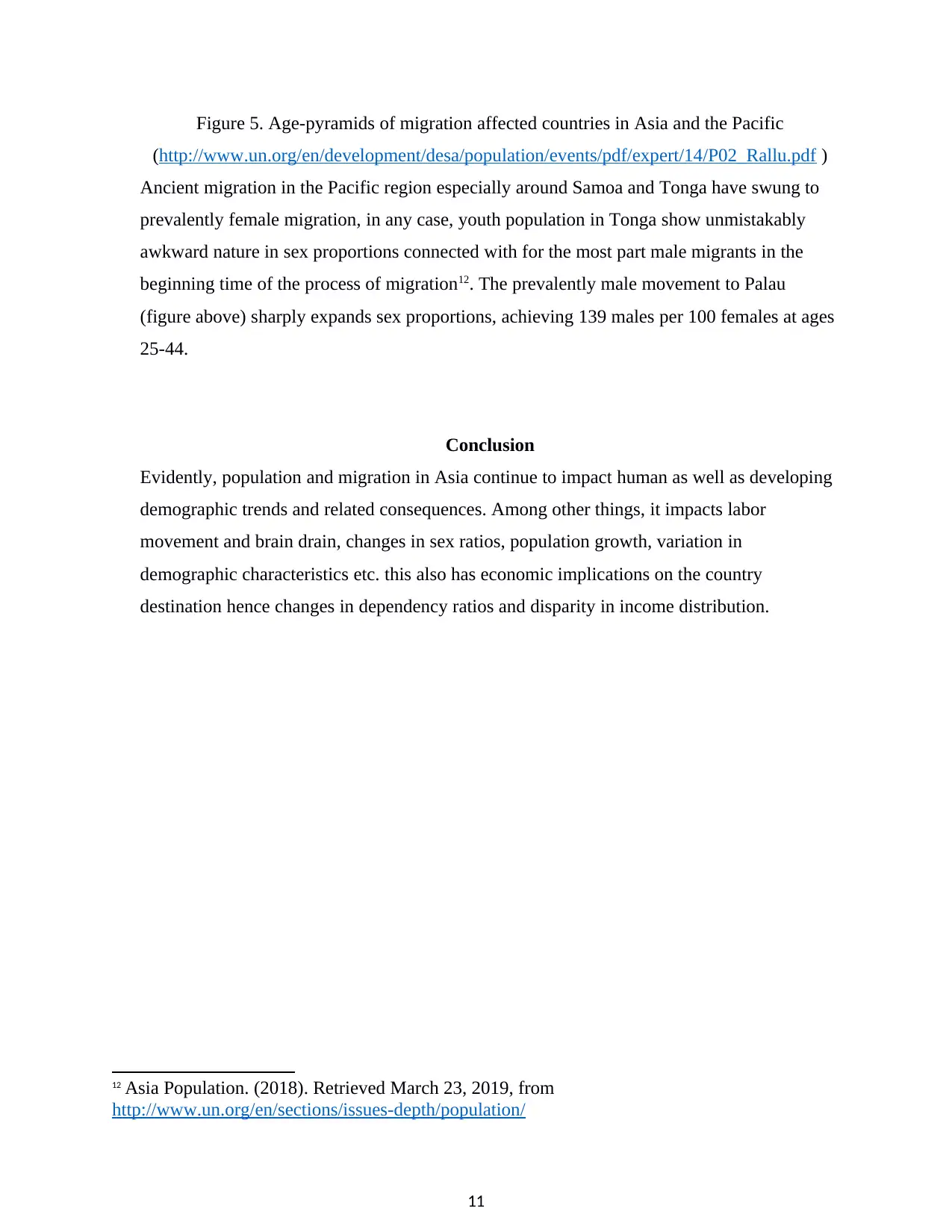
Figure 5. Age-pyramids of migration affected countries in Asia and the Pacific
(http://www.un.org/en/development/desa/population/events/pdf/expert/14/P02_Rallu.pdf )
Ancient migration in the Pacific region especially around Samoa and Tonga have swung to
prevalently female migration, in any case, youth population in Tonga show unmistakably
awkward nature in sex proportions connected with for the most part male migrants in the
beginning time of the process of migration12. The prevalently male movement to Palau
(figure above) sharply expands sex proportions, achieving 139 males per 100 females at ages
25-44.
Conclusion
Evidently, population and migration in Asia continue to impact human as well as developing
demographic trends and related consequences. Among other things, it impacts labor
movement and brain drain, changes in sex ratios, population growth, variation in
demographic characteristics etc. this also has economic implications on the country
destination hence changes in dependency ratios and disparity in income distribution.
12 Asia Population. (2018). Retrieved March 23, 2019, from
http://www.un.org/en/sections/issues-depth/population/
11
(http://www.un.org/en/development/desa/population/events/pdf/expert/14/P02_Rallu.pdf )
Ancient migration in the Pacific region especially around Samoa and Tonga have swung to
prevalently female migration, in any case, youth population in Tonga show unmistakably
awkward nature in sex proportions connected with for the most part male migrants in the
beginning time of the process of migration12. The prevalently male movement to Palau
(figure above) sharply expands sex proportions, achieving 139 males per 100 females at ages
25-44.
Conclusion
Evidently, population and migration in Asia continue to impact human as well as developing
demographic trends and related consequences. Among other things, it impacts labor
movement and brain drain, changes in sex ratios, population growth, variation in
demographic characteristics etc. this also has economic implications on the country
destination hence changes in dependency ratios and disparity in income distribution.
12 Asia Population. (2018). Retrieved March 23, 2019, from
http://www.un.org/en/sections/issues-depth/population/
11
⊘ This is a preview!⊘
Do you want full access?
Subscribe today to unlock all pages.

Trusted by 1+ million students worldwide
1 out of 12
Your All-in-One AI-Powered Toolkit for Academic Success.
+13062052269
info@desklib.com
Available 24*7 on WhatsApp / Email
![[object Object]](/_next/static/media/star-bottom.7253800d.svg)
Unlock your academic potential
Copyright © 2020–2025 A2Z Services. All Rights Reserved. Developed and managed by ZUCOL.